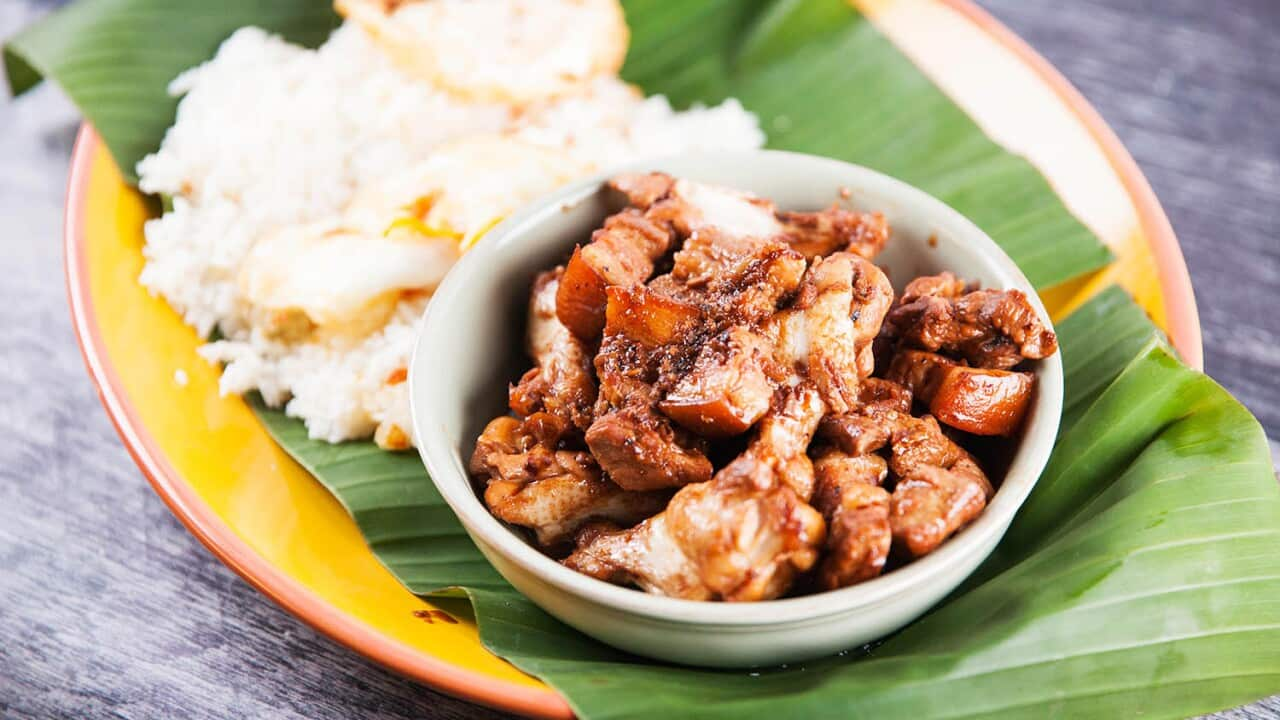For many Filipinos living overseas and in the Philippines, homestyle cooking isn't something people often eat in restaurants.
"That food only happens at home," says Luisa Brimble, photographer and member of the Australian chapter of the Filipino Food Movement. "There's this mentality: Why go out when my mum could cook it better at home?"
The idea that home cooking is superior to restaurant cooking is one of the theories why Filipino food isn't as ubiquitous in Australia as other Asian cuisines.
Filipinos represent the fifth largest migrant group in Australia, after people from England, China, India and New Zealand. In 2019, there were in Australia, which is more than people from Vietnam and Malaysia.
It seems incongruous then that places to eat pho or pad thai abound, but if you asked someone where to get chicken adobo they might draw a blank.
With the exception of a handful of inner-city venues, Filipino food is mostly served in outer suburbs. In Sydney, the Filipino migrant community has traditionally settled in western suburbs like Blacktown and Seven Hills, and there are plenty of Filipino eateries to service the locals.
But unlike Chinese cuisine where, for example, people without Chinese heritage are well versed in the country's diverse range of regional dishes, Filipino establishments haven't proliferated much in areas outside the Filipino suburbs.
YOU'RE WELCOME

Have you tried Filipino food yet? If not, now’s the time
According to chefs and champions of Filipino food and culture, there isn't an easy explanation. It has to do with culture, history and expectation.
Will Mahusay, owner of Sydney Cebu Lechon in Newtown, attributes it to the natural caution of migrants leaving home seeking a better future.
"Many first-generation migrants probably think, 'We need to do something safe, like work in a hospital or a warehouse to earn money and establish ourselves so our kids don't have to go through what we went through," he says.
The migrant burden is heavy. "They uprooted their family to come here, so they choose a sure thing, rather than opening an eatery.
"That leaves a minority of people trying to put Filipino food on the map. They think, 'If we take a risk, our kids might not have a good quality of life because we gambled it all away'." If Filipino migrants tend to seek out a conservative path, many also choose one that fits well with their adopted home.
If Filipino migrants tend to seek out a conservative path, many also choose one that fits well with their adopted home.

Once Australians are introduced to Filipino food like lechon - slow-roasted pork that's loved for its flavourful crackling - we're unlikely to look back. Source: Will Mahusay
"I remember when I arrived in Australia, I never had Filipino friends," says Luisa Brimble, who moved to Sydney when she was 18. "I tried to assimilate as much as I could.
"It happens with a lot of migrants. It's a rejection of culture: When you're in a different environment, you have to try to fit in."
Grace Guinto, lawyer and one of the founders of , a Melbourne-based collective of women promoting Filipino food and culture, believes that Filipinos' ability to assimilate is ingrained in a culture shaped by centuries of colonisation.
"Assimilation goes back to various times of occupation in the Philippines. When a person moves away, I think they say to themselves, 'I will forgo my language, my food, my culture to show that I'm the model migrant'," she says.
SHOWING AUSTRALIA WHAT'S TO LOVE ABOUT FILIPINO FOOD

Meet the Pinays unleashing a Filipino flavour storm
The Philippines was under Spanish rule for over 300 years until 1868 when it became a territory of the United States, ceded as part of the Spanish-American war. Then, the Japanese occupied the Philippines during WWII, after which the country gained independence.
Guinto says centuries of colonisation developed in Filipinos a trait called "hiya", which is similar to being self-effacing. The opposite is "walanghiya" or shameless. "Hiya was a defence mechanism against the colonisers."
Assimilation was the key to survival.
She shares a story from her family. "My dad didn't live through the war, but he ate ("ah-teh", older sister) did. They had a bit of Spanish heritage and were more Eurasian-looking. They had to hide from the Japanese because they were an easy target to kill to make the point to the Americans: If you fraternise with westerners, you're the enemy.
"Assimilation was the key to survival."
The landscape of Filipino cuisine is shifting as groups like Entrée Pinays, a Filipino Food Movement, and eateries promote Filipino food, and the concept of "Pinoy Pride" comes to the forefront.
Guinto says in Australia we're still in the infancy of people's understanding of Filipino food, and that it's very Manila or northern-centric, with adobo, pancit and lumpia acting as a shorthand for Filipino cuisine.
"There are a lot of regional differences in Filipino cuisine," says Kristina Náray, Guinto's colleague at Entrée Pinays. "If you live close to the sea, you eat things from the ocean. In the mountains, it's more plant-based food. In the city, there's a lot of packaged food, which comes from the American influence and the fact that it's harder to get fresh produce in the city."
But regardless of the region, Filipino food is inextricably linked to Filipino culture. In fact, a common greeting is "kumain ka na ba?" or "did you eat yet?" So as people become familiar with Filipino food, they'll also better understand the culture of the 294,000 migrants who've chosen Australia as home.
"It's just a matter of time until everybody is eating adobo and lechon," Brimble says.
premieres Thursday, June 3 at 8:30 pm on SBS, with the full series also available then at SBS On Demand (full-series drop).
ALL ABOUT FILIPINO FOOD

Talking TV, family adobo and Filipino mums with Michelle Vergara Moore







